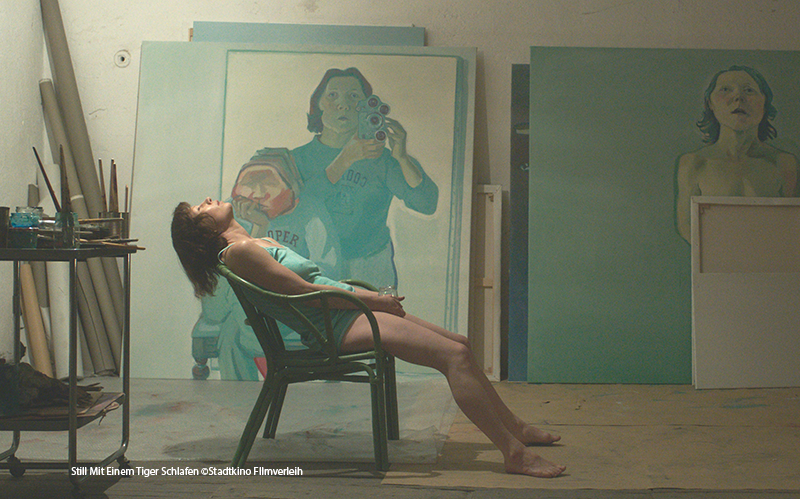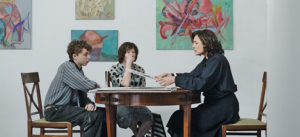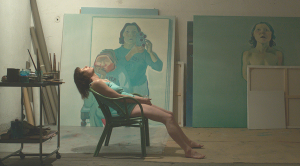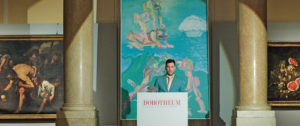
Film Star
Maria Lassnig, a giant of international painting, is the focus of an unconventional anti-biopic by Austrian director Anja Salomonowitz. Entitled Sleeping with a Tiger, the film presents a nuanced and poetic portrayal of the late-recognised artist’s life, with Birgit Minichmayr as the lead part and Dorotheum in a supporting role.
Sleeping with a Tiger is the title of one of Maria Lassnig’s most striking paintings. It is also the name of a film by Anja Salomonowitz which premiered at the Berlinale in February this year. In an interview with Dorotheum’s myART MAGAZINE, the Austrian director discusses several different interpretations of the painting and its title: “Grappling with
the world, conquering the world. That can be an outer – but also an inner world. Some say the tiger is her.”

The same sense of ambiguity pervades the entire film, which also marks a departure from the traditional biopic. Salomonowitz speaks in terms of a poetic interpretation punctuated by flashbacks and flash-forwards along with various documentary elements, such as Elfie Semotan’s on-camera recollections of Lassnig. A key feature of the narrative, scripted from the outset, was that each stage of the world-famous painter’s life – Lassnig died in 2014 at the age of 94 – would be played by one and the same person. Birgit Minichmayr excelled in the role, much to Salomonowitz’s delight. One of the finest actresses of her generation, the Burgtheater star allows the film to take on a life of its own. Minichmayr, has described the role as the most demanding of her career.
“Maria is back”, thought a startled Hans Werner Poschauko at his first sight of the wigged Minichmayr in character as Lassnig in her wheelchair. The former assistant and confidant of Maria Lassnig and member of the Maria Lassnig Foundation, (played in the film by Lukas Watzl) praised the actress’ artistry. He recalls, for example, demonstrating the way in which Lassnig handled her brush to the actress and “within seconds she had inhaled it”.

Poschauko, who visited his former university professor Lassnig, between 4 and 6pm every day for the last seven years of her life and co-published her film work with her, was a crucial source of information for Salomonowitz when it came to translating Lassnig’s depictions of feelings into cinematic images. It is after all emotion, an existential interiority, that sits at the heart of Lassnig’s entire oeuvre. Poschauko recalls that Lassnig pioneered a new category of painting, body awareness painting, as early as 1948. “She would sit in this armchair that she used every day in the studio, close her eyes and notice how the chair penetrated her, how she merged with it”, he says. “She would then paint that bodily sensation”, he recalls. Equally gifted with language, the artist – who was much admired by the Austrian writer, Peter Handke – assigned specific colours and names to different emotions, from “colours of pressure and tension” to “colours of fear of decay and cancer”. Many consider Lassnig an anomalous figure in the history of art, Poschauko among them. “What would you call your style of painting?” he once asked her. Her reply: “The new drastic school.”

It wasn’t until her ninth decade that Lassnig received the recognition she deserved. She was awarded the Golden Lion for Lifetime Achievement at the Venice Biennale shortly before her death at 94 years old, and lived to witness a rapturously reviewed, publicly
acclaimed retrospective at the MoMA in New York. She had also experienced first-hand the total male domination of the art market in the 1950s, a humiliation and disappointment she carried with her all her life. A scene from Sleeping with a Tiger shows Lassnig and her partner Arnulf Rainer (Oskar Haag), who was ten years her junior, presenting their portfolios to a female gallery owner (Sophie Semin, little side note: the French woman is Peter Handke´s partner) in Paris. Lassnig is relegated to the role of interpreter, while Rainer is invited to return. By contrast, notes Salomonowitz, the painter’s belated recognition on the international art market is depicted in a scene with Dorotheum auctioneer Rafael Schwarz. In it, Schwarz lists the most recent auction results for Lassnig’s paintings.

What can viewers take away from the film if they are not familiar with Lassnig? Salomonowitz mentions, among other things, “an unyielding determination and approach to the search for creativity. A way of living the search for meaning. A form of immortality that goes beyond oneself.”













